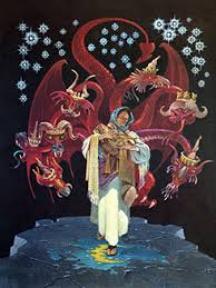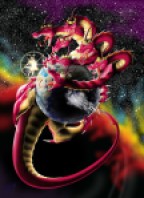This excerpt from Mike Wilcox’s book “Who shall be able to stand: Finding personal meaning in the Book of Revelation” is just pure gold. He is a brilliant writer, if you haven’t read anything by him, you need to go and pick up one of his books.
Revelation 12:6-13

Verses 6 through 13 of Revelation 12 can be read as an interlude, interjected into the narrative. We could put parentheses around these verses to set them off, a common literary and scriptural technique. Verse 14 is a repetition of verse 5, albeit using different wording: “Therefore, to the woman were given two wings of a great eagle, that she might flee into the wilderness, into her place, where she is nourished for a time, and times, and half a time, from the face of the serpent.” (Revelation 12:14, JST.) The expression “time, times, and half a time” originates in Daniel. (See Daniel 7:25.) There the time delineated meant a period of apostasy and trial, as even a cursory reading will reveal. The phrase is akin to forty-two months, three and a half years, and one thousand two hundred and sixty days.
The time in the wilderness seems to best represent the great apostasy, the time of Lucifer’s most total power. He now claimed what the Old Testament accords only to Jesus, the right to rule “from the river unto the ends of the earth.” (Psalms 72:8; see also Zechariah 9:10.) In the New World, the lights went out completely with the last great battles of the Nephites and Lamanites at the time of Mormon and Moroni. The sacred plates were buried, and within a few centuries almost all remnants of Christian belief were eclipsed in the mystery religions of the Maya, Aztec, and other groups on this continent. Only fleeting shadows of a white god who promised to return, along with some distorted rituals, remained as witness of the American gospel. Using John’s imagery, we might say that the woman died in the wilderness jungles of the Americas. Yet even here, the buried plates with their precious messages would not perish.

However, in the Old World, in spite of the apostasy, Christianity survived. Though changed in many of its doctrines, ordinances, and priesthood, many essential truths remained. Most remarkable, the scriptures survived. Some “plain and precious truths” were removed, but what endured still carried a rich fullness. The belief in resurrection, baptism, sacrament, atonement, priesthood, and scripture, though all distorted, continued to exist. The story of Christianity’s survival in Europe is a fascinating tale, and one we cannot undertake in the context of this book. We owe a deep debt of gratitude to hundreds of individuals who preserved, copied, debated, lived, displayed in art, and passed on the tenets of Christ’s teachings. The great cathedrals of Europe have always filled me with thanksgiving, in spite of their more somber elements, for they represent the triumph of the woman over the dragon. This is not to deny the condemnation of the apostate church that will be discussed in chapter 17 but to give credit where credit is due and validate the Lord’s wisdom in keeping the woman from annihilation. She fled into a gentile wilderness and lived. The reason the Restoration had to come through the Gentiles and not the house of Israel is that they were the only ones who believed in Christ and still read and studied his teachings. (See 3 Nephi 16:6- 7.) God prepared a place for the woman in the monasteries, kingdoms, artworks, cathedrals, and writings of Europe. She was nourished and passed through a Reformation, and enough was left to send a fourteen-year-old boy into a grove of trees in response to a verse of scripture still surviving after nearly two thousand years of apostasy. When coupled with the surviving remnant of the New World buried in a hill by the Smith farm, the woman would arise out of the wilderness to shine clear as the sun and fair as the moon. (S. Michael Wilcox, Who Shall Be Able to Stand: Finding Personal Meaning in the Book of Revelation)
